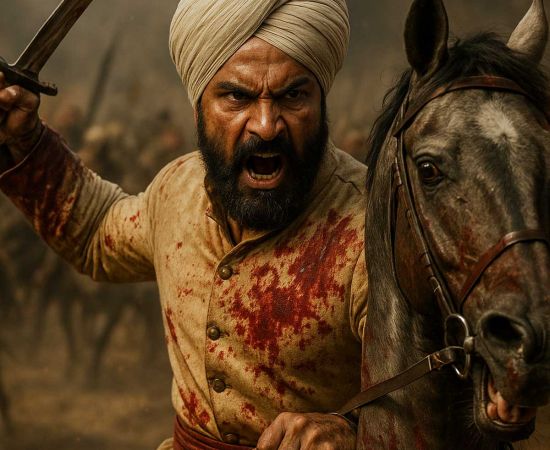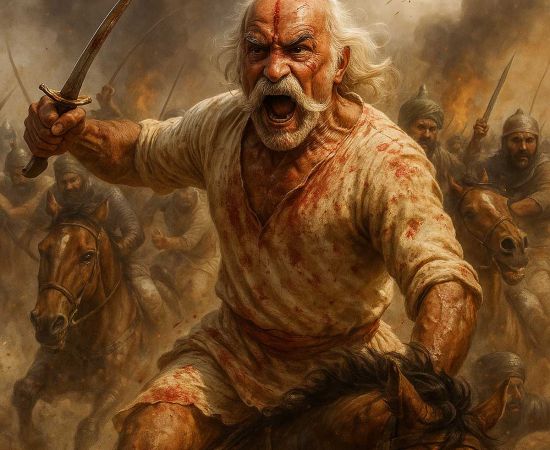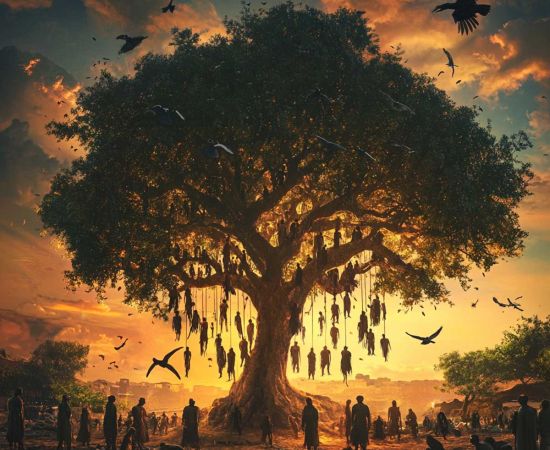MORE COVERAGE
Twitter Coverage
Satyaagrah
Written on
Satyaagrah
Written on
Satyaagrah
Written on
Satyaagrah
Written on
Satyaagrah
Written on
JOIN SATYAAGRAH SOCIAL MEDIA
"From Muslim to Sikh to Extremist": Toofan Singh, a Nihang Sikh & former Muslim, falsely accused Bageshwar Dham Sarkar of targeting Sikhs, leading to baseless threats. Sarkar's actual warning was against Christian missionaries converting Hindus in Punjab
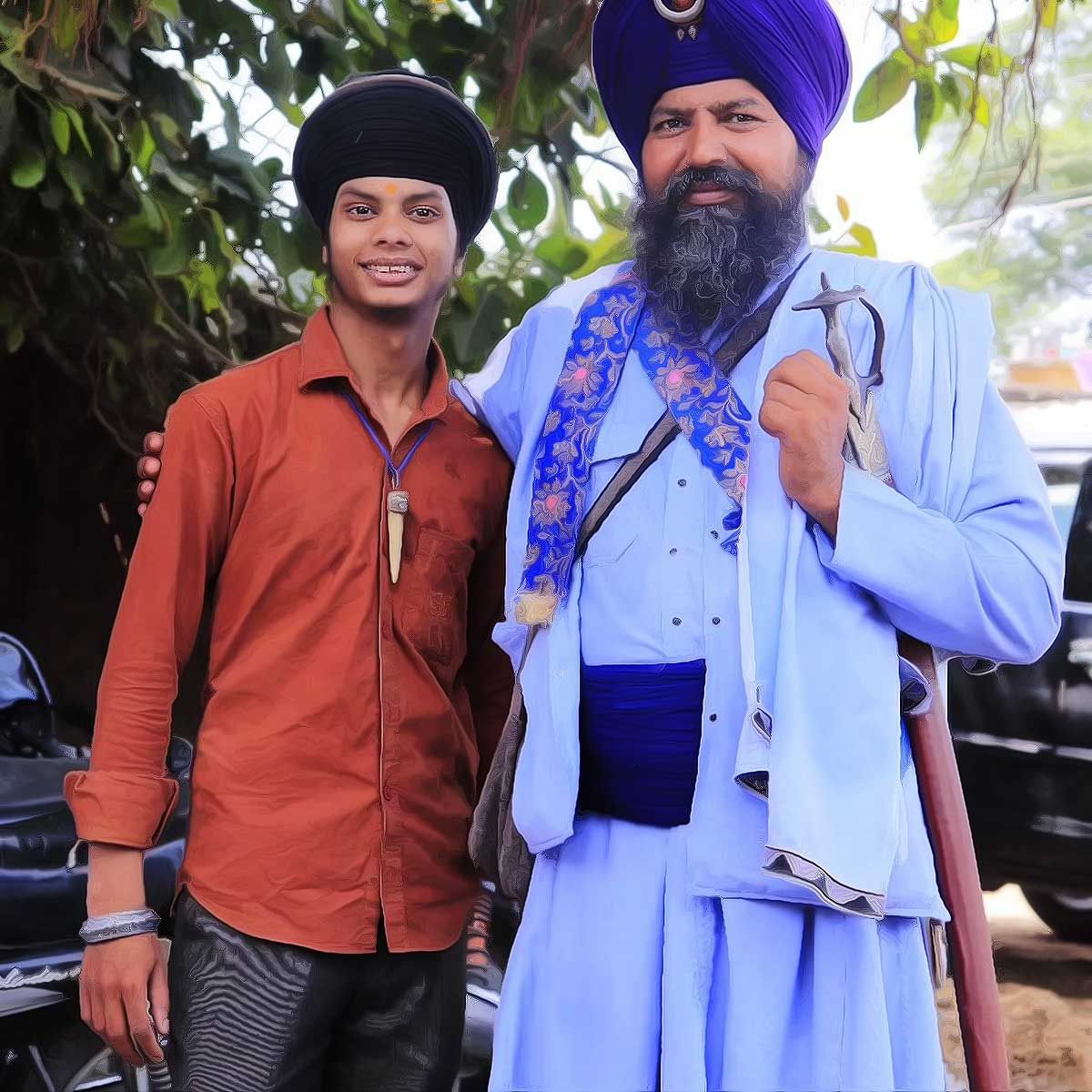
The recent video posted by Harmandeep Singh, known as Toofan Singh, a self-identified Khalistani Nihang Sikh, has sparked significant attention on social media. Posted on November 1 on his Instagram account, the video features Singh issuing a direct threat to Bageshwar Dham Sarkar Dhirendra Krishna Shastri, a claim that has stirred up considerable controversy and discussion.
|
In the video, Toofan Singh accuses Bageshwar Dham Sarkar of threatening Sikhs and Punjabis, a serious allegation that reflects ongoing tensions and sensitivities within different religious and cultural groups in India. His statement, “He is threatening Sikhs. He is threatening Punjabis. Share my video with him. I want to convey to him, ‘young man, those whom you threaten, we encounter at least 20 like you every day. We don’t incite anyone, but when the need arises, we willingly sacrifice for our religion and even for others’. Are you challenging us? Go and challenge your own father. After saying all this, try entering Punjab. We will confront and teach you ‘how to issue threats’. We don’t just threaten; we take action,” is a clear and forceful message that underscores his defiant stance and his readiness to defend his beliefs and community.
This incident raises questions about the nature of religious and cultural discourse in the country, particularly in the context of social media where such statements can rapidly circulate and escalate tensions. The use of strong and confrontational language by Toofan Singh points to a deeper issue of how religious and cultural disagreements are being expressed and addressed in contemporary society.
The widespread attention the video has received indicates a public interest and concern over these issues. It highlights the need for careful and respectful dialogue between different communities to foster understanding and peace. This situation also serves as a reminder of the power of social media as a platform for expression and the responsibility that comes with it.
The situation surrounding Toofan Singh's video and the statements made by Bageshwar Dham Sarkar, a religious leader, highlights the complex and sensitive nature of religious discourse in India. Toofan Singh's video response was triggered by a brief excerpt from a speech by Bageshwar Dham Sarkar, which, upon further investigation, reveals more about the context of his original message.
In his speech, Bageshwar Dham Sarkar was addressing the issue of Christian missionaries involved in conversion campaigns in Punjab, rather than making comments about the Sikh community. His statement, “To those opposing me in Punjab, I have a message. Listen to me and understand what I am saying. I am not against you, but if you create trouble for Sanatanis, we will take action. You won’t reap a harvest if you don’t sow a seed. I urge the Punjab government to consider a stringent anti-conversion law. Sanatanis do not engage in conversion in Punjab; we only support Ghar Wapsi. I humbly request the Punjab government to enact a strict anti-conversion law. Innocent people are being harassed, and this poison is spreading. To those of other religions who feel offended, I want to convey that this issue will persist,” reveals his stance against forced conversion and his appeal for a stringent anti-conversion law.
During his visit to Punjab on October 22, Bageshwar Dham Sarkar's actions, including touring the Golden Temple and Durgyana Mandir, and his appreciation for the warm reception from Sikhs, further clarify his position. His comments to reporters focus on the issue of religious conversions, a topic of significant concern in many parts of India. He emphasizes, “I urge these individuals to refrain from entering gurdwaras and temples and from enticing innocent Hindus or individuals of any faith. That’s why I am traveling across the country. Until stringent laws are enacted against ‘troublemakers,’ they will persist in luring innocent Hindus for conversion.” This statement indicates his broader concern about the impact of religious conversions on the Hindu community and his call for legal measures to address it.
The misinterpretation of Bageshwar Dham Sarkar’s words by Toofan Singh and the subsequent social media response underline the challenges of communication and perception in a diverse and multi-religious society like India. It also highlights the need for responsible sharing and interpretation of information, especially on platforms like social media where context can be easily lost or distorted.
The controversy involving Bageshwar Dham Sarkar, a religious leader, further escalated due to his specific targeting of Christian missionaries in Punjab. This situation has become increasingly complex as it touches upon sensitive religious and communal dynamics in the region.
Bageshwar Dham Sarkar's contentious statement, where he asserted that he would not allow those who chant ‘hallelujah’ to convert Hindus without consequences, has intensified the debate. This comment can be interpreted as a direct challenge to the activities of Christian missionaries in the region, particularly those perceived as aggressively pursuing conversion of Hindus.
In response to these remarks, a Christian organization in Punjab took official action. Jatinder Gaurav from the Global Christian Action Committee accused Bageshwar Dham Sarkar of using derogatory language against Christians and called for legal action. Gaurav's statement, “Baba has come from outside and is attempting to disrupt the peace in Punjab. He is singling out the word… wherever he goes in Punjab, targeting the Christian community. The police have assured us that appropriate legal action will be taken on our complaint. We will escalate our protest if no action is taken,” reflects the growing tensions and the sense of grievance felt by the Christian community.
It is important to note that Bageshwar Dham Sarkar’s statements were not directed against Sikhs or the general populace of Punjab. His focus was solely on Christian missionaries and the issue of conversions. However, Toofan Singh, a Khalistani Nihang Sikh, misinterpreted these statements as being against Sikhs, leading him to issue threats against Bageshwar Dham Sarkar in his video.
|
This situation highlights the volatile nature of religious discourse in India, where misunderstandings and misinterpretations can quickly escalate into broader communal tensions. The incident underscores the need for careful and sensitive communication on matters of religion, especially in a diverse and multi-faith society. The repercussions of such misunderstandings can be far-reaching, affecting not only the individuals involved but also the broader community dynamics.
The emergence of Toofan Singh as a significant figure on social media, especially in the wake of his video threatening Bageshwar Dham Sarkar, has led to questions about his background and the reasons behind his growing influence. A deeper look into Toofan Singh's past activities reveals a pattern of involvement in controversial and radical activities.
Toofan Singh has been associated with endorsing and supporting figures known for their pro-Khalistan stance. His support for Khalistani terrorist Jarnail Singh Bhindranwale and pro-Khalistan separatist Amritpal Singh indicates a strong alignment with radical views. This endorsement is particularly significant given the historical and ongoing complexities surrounding the Khalistan movement in India, which seeks a separate Sikh state. Such associations suggest that Toofan Singh's viewpoints and actions are deeply rooted in a specific political and ideological framework that resonates with certain segments of the Sikh community but may be viewed as extreme or divisive by others.
Toofan Singh's involvement in a violent protest in Chandigarh further cements his reputation as a radical figure. The incident, where Sikh protesters clashed with the police, leading to the police's retreat, underscores the intensity and potentially volatile nature of such demonstrations. Toofan Singh's active participation in this protest and his wearing of a bulletproof jacket taken from the police during the clash is a symbolic gesture of defiance and resistance. It portrays him not just as a passive supporter but as an active participant in movements that challenge the status quo.
This background provides context to Toofan Singh's recent actions and statements, especially his aggressive stance against Bageshwar Dham Sarkar. It reflects a broader narrative of religious and political activism that often intersects with issues of identity, sovereignty, and community rights. The attention he receives on social media indicates the resonance of such narratives in the digital age, where platforms can amplify voices and viewpoints, sometimes leading to increased polarization and tension.
The personal history and evolution of Toofan Singh, as revealed in a video interview with Rozana Spokesman in August 2021, shed light on his journey and the factors that may have influenced his current beliefs and actions. His story of losing his mother at a young age and being left at a Gurdwara in Amritsar, where he was raised and embraced Sikhism, despite being born into a Muslim family, paints a picture of a complex individual shaped by unique circumstances. This background provides a deeper understanding of his identity and his strong connection to Sikhism, which appears to have been a cornerstone of his life since childhood.
However, the transformation from a young individual devoted to Sikhism to someone actively involved in violent confrontations is a significant shift. The incident in February 2023 near the Chandigarh-Mohali border is particularly telling. This violent clash involved armed Sikh protesters from the Kaumi Insaaf Morcha and resulted in injuries to at least 33 police personnel, including female officers, and damage to numerous police vehicles. The protesters were advocating for the release of Sikh prisoners, known as Bandi Sikhs, some of whom were convicted in the assassination of Beant Singh, a former Chief Minister of Punjab.
Toofan Singh's active participation in this assault and his subsequent wearing of police anti-riot gear, which he claimed to have acquired after police personnel abandoned it, is a notable escalation in his involvement in such activities. His portrayal of the gear as a symbol of victory over the "Bhaiye," a derogatory term for people from UP and Bihar residing in Punjab, indicates a deep-seated sense of regional and cultural identity, as well as a willingness to engage in acts of defiance and resistance against perceived injustices.
This background and the escalation of his activities highlight the complexities surrounding Toofan Singh's character and actions. They raise questions about the influences that have shaped his path from a devout follower of Sikhism to a radical figure involved in violent protests.
The age and background of Toofan Singh, a figure who has recently gained significant attention, remain somewhat shrouded in mystery. In an interview following his involvement in protests, he claimed to be in the 9th standard, suggesting a relatively young age. This detail, emerging after his name appeared on the list of wanted protesters, adds another layer to the complex picture of his identity and the path that has led him to his current stance.
Toofan Singh's support for Amritpal Singh, a figure known for his activism and currently incarcerated in Assam, is another critical aspect of his persona. In a video, Toofan Singh lauded Amritpal Singh for returning to India from Dubai, where he had a business, to work for the betterment of Sikhs. This endorsement came after Amritpal Singh evaded central agencies and the Punjab Police, highlighting Toofan Singh's alignment with figures who challenge the status quo and are involved in significant political and social movements.
The controversy surrounding the video Toofan Singh released against Bageshwar Dham Sarkar further complicates his public image. His interpretation of Bageshwar Dham Sarkar’s statements, which led to the issuance of threats, was founded on a misunderstanding. This misinterpretation has not only escalated tensions but also raised questions about the dissemination of information and the responsibility of individuals in positions of influence, particularly in the age of social media where content can rapidly spread and incite reactions.
Toofan Singh's actions and the narratives he engages with reflect broader issues in contemporary society, including the role of youth in political and social activism, the impact of misinformation, and the complexities of navigating identity and belief in a multi-ethnic and multi-religious context. His journey from a young individual devoted to Sikhism to a figure involved in radical activities and controversial statements underscores the need for nuanced understanding and dialogue in addressing issues of radicalization, misinformation, and communal tension.
As Toofan Singh continues to be a subject of public interest and scrutiny, it becomes increasingly important to consider the broader societal and cultural factors that contribute to such trajectories, and to seek ways to engage constructively with young individuals who find themselves at the center of complex social and political dynamics.
Who is Toofan Singh?
The growing attention and intrigue surrounding Toofan Singh, particularly on social media, raise questions about his background and the factors that have influenced his radical views and actions. A deep dive into his history reveals a trajectory marked by support for controversial figures and involvement in intense political activism.
From a young age, Toofan Singh has been aligned with radical ideologies, as evidenced by his support for Khalistani terrorist Jarnail Singh Bhindranwale and pro-Khalistan separatist Amritpal Singh. This support reflects a deep-seated belief in the Khalistan movement, which advocates for a separate Sikh state and has been a source of significant political tension and conflict in India.
Toofan Singh's participation in a violent protest in Chandigarh, where aggressive Sikh protesters forced the police to retreat, further highlights his active involvement in radical activities. His choice to wear a bulletproof jacket taken from the police during this clash is symbolic of his defiance and alignment with the protest's cause. This incident garnered considerable media attention, casting Toofan Singh as a prominent figure in such movements.
However, Toofan Singh's background is complex and multi-layered. In an August 2021 video interview with Rozana Spokesman, he revealed a personal history marked by tragedy and transformation. Losing his mother at the age of four and being left at a Gurdwara in Amritsar by his father, Toofan Singh grew up in a religious environment that deeply influenced his identity. Born into a Muslim family, he embraced Sikhism as he got older, indicating a profound shift in his religious and cultural identity.
At one time, Toofan Singh was perceived as a young and innocent individual who was earnestly devoted to following Sikhism. This image contrasts starkly with his later involvement in radical activities and movements, suggesting a significant evolution in his beliefs and actions over time.
The incident in February 2023 near the Chandigarh-Mohali border serves as a stark reminder of the intensity of certain political and social movements in India, particularly those involving the Sikh community. The clash, which resulted in injuries to at least 33 police personnel, including female officers, and extensive damage to police vehicles, was a significant and violent confrontation.
The protesters, part of the Kaumi Insaaf Morcha, were advocating for the release of Sikh prisoners known as Bandi Sikhs, some of whom were involved in the assassination of Beant Singh, a former Chief Minister of Punjab. This context is crucial in understanding the motivations and intensity of the protest. The demand for the release of these prisoners highlights ongoing tensions and unresolved issues within the Sikh community, particularly regarding perceived injustices and the treatment of individuals involved in politically sensitive cases.
Toofan Singh's involvement in this protest and his subsequent actions are indicative of his radical stance and willingness to engage in violent confrontations. His wearing of police anti-riot gear, which he claimed to have picked up as a symbol of victory over the “Bhaiye” – a derogatory term for people from Uttar Pradesh and Bihar living in Punjab – is a provocative act. It not only demonstrates his active participation in the clash but also reflects a deep-seated regional and cultural animosity that goes beyond the immediate context of the protest.
This incident, and Toofan Singh's role in it, underscore the complex interplay of regional, cultural, and political dynamics in India. The use of derogatory terms and the targeting of specific groups reveal underlying tensions and prejudices that can exacerbate conflicts and lead to violence. It also highlights the challenges faced by law enforcement in managing protests that are charged with deep-rooted emotions and historical grievances.
Toofan Singh's actions in this confrontation, along with his previous activities and statements, paint a picture of an individual deeply entrenched in certain ideologies and causes. His journey from a young boy in a Gurdwara to a radical figure involved in violent protests is a trajectory that raises questions about the factors that drive such radicalization and the broader societal implications of these movements.
|
The lack of specific information about Toofan Singh's age, combined with his claim of being in the 9th standard during an interview conducted after he was listed as a wanted protester, suggests that he may be relatively young. This aspect of his profile is significant as it points to the involvement of youth in radical movements and the ways in which they can be influenced and mobilized through social media and other platforms.
Toofan Singh's Instagram account reveals further insights into his beliefs and activities. The presence of a video where he is seen shooting guns is a potent symbol of his militant stance and readiness to engage in armed actions. This kind of imagery not only reflects his personal views and commitments but also has the potential to influence and inspire others who follow him on social media.
His choice to wear a t-shirt with a photograph of Bhindranwale, a controversial figure associated with the Khalistan movement, is another clear indication of his ideological leanings. This kind of visual endorsement serves to reinforce his alignment with the Khalistani cause and his identification with its leaders and symbols.
Toofan Singh's rhetoric on social media, particularly his framing of the struggle as a “fight with the government,” is in line with standard pro-Khalistani narratives. This perspective focuses on issues like the suppression of Sikhs and the non-release of Sikh prisoners. His assertion that the conflict does not involve scuffles with Hindus or Muslims suggests an attempt to frame the struggle in specific political and communal terms, distancing it from broader religious conflicts.
His support for Amritpal Singh, who he claims left a business in Dubai to work for the betterment of Sikhs, further aligns Toofan Singh with figures who are seen as champions of the Sikh cause. The context of this support – following Amritpal Singh's evasion of law enforcement and subsequent arrest – indicates Toofan Singh's continued commitment to these figures and causes, even in the face of legal actions.
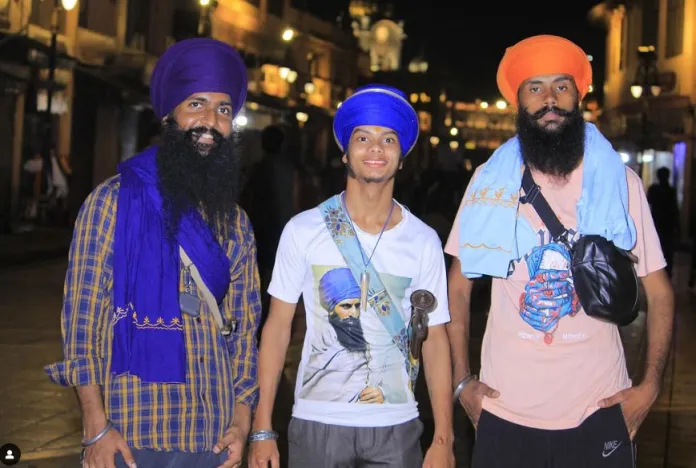 |
| Source: Instagram/Toofan Singh |
The broader issue highlighted by Toofan Singh's profile and actions is the role of influencers on social media in propagating certain ideologies, including pro-Khalistan and anti-India sentiments. His misinterpretation of Bageshwar Dham Sarkar's statements and his decision to issue threats based on this misunderstanding point to the dangers of misinformation and the lack of contextual understanding in such environments.
Toofan Singh's actions and the content he shares on social media are part of a larger phenomenon where online platforms are used to spread specific narratives and mobilize support. His case underscores the need for careful monitoring of such content and the importance of providing young people with the skills and knowledge to critically evaluate the information they encounter online. As social media continues to play a significant role in shaping opinions and movements, understanding and addressing these dynamics becomes crucial in maintaining social harmony and preventing radicalization.
 Support Us
Support Us
Satyagraha was born from the heart of our land, with an undying aim to unveil the true essence of Bharat. It seeks to illuminate the hidden tales of our valiant freedom fighters and the rich chronicles that haven't yet sung their complete melody in the mainstream.
While platforms like NDTV and 'The Wire' effortlessly garner funds under the banner of safeguarding democracy, we at Satyagraha walk a different path. Our strength and resonance come from you. In this journey to weave a stronger Bharat, every little contribution amplifies our voice. Let's come together, contribute as you can, and champion the true spirit of our nation.
 |  |  |
| ICICI Bank of Satyaagrah | Razorpay Bank of Satyaagrah | PayPal Bank of Satyaagrah - For International Payments |
If all above doesn't work, then try the LINK below:
Please share the article on other platforms
DISCLAIMER: The author is solely responsible for the views expressed in this article. The author carries the responsibility for citing and/or licensing of images utilized within the text. The website also frequently uses non-commercial images for representational purposes only in line with the article. We are not responsible for the authenticity of such images. If some images have a copyright issue, we request the person/entity to contact us at This email address is being protected from spambots. You need JavaScript enabled to view it. and we will take the necessary actions to resolve the issue.
Related Articles
- "We will see where their Kali Mata will go to hide and who forced your Durga to dance naked” the Nihang Sikh insulted and threatened Hindus with violence after Khalistanis unleashed violence in Patiala
- How Republic day 2021 succumbed to violence and desecration of Indian tricolor at the Red Fort created shock waves across the country: Khalistanis gave a call to pick up arms on social media apps
- Dangerous plots of Khalistan uprising and Hindu genocide, hurling abuses to Hindu Gods, arrest of Hindus for ‘blasphemy’ when retaliating - The menacing truth of underbelly of Clubhouse
- Call raised for a Patiala Bandh by Hindu Groups after armed Khalistani mob attacked a Kali temple and ran amok in the city brandishing swords: FIR registered against Khalistanis
- "Khalistani ideology is mainly a catalogue of blunders": Punjab Police recovered incriminating material including holograms of Anandpur Khalsa Fauj, a firing range built by Amritpal Singh, and weapon training videos from Tejinder Singh alias Gorkha Baba
- "जोबोले सो निहाल": A Nihang Sikh in Punjab again kills over sacrilege claims, posting a pre-murder video, this shocking act adds to a disturbing trend of violence in Sikhi, following a history of similar sacrilege-related cases & escalating confrontations
- Barjinder Singh Parwana instigated Sikhs for Patiala violence against the ‘Khalistan Murdabad March’: Urged armed Sikhs to gather from all over Punjab, famous Maa Kali Mandir was attacked by Nihang Sikhs
- Brutal violence by Nihang Sikhs: Zomato executive Sagar Singh stabbed with kirpan and head smashed with bricks by two Nihang Sikhs for ‘smoking on roadside, was lying in a pool of blood for 20 mins but none of bystanders stepped in to help
- Sikhs for Justice General Council from the USA took the responsibility for blocking Modi in Punjab: SC Lawyers get threatening calls from Khalistani organization SFJ
- At Canada’s Khalsa Day Parade, terrorist Santokh Singh Khela stood with Pierre Poilievre as “Kill Modi” chants rang out, Khalistani flags waved, Nijjar was glorified, and SFJ terrorists pushed their anti-India agenda with jailed Modi cutouts on display
- Lakhbir Singh killer Nihang Sikh felicitated with garland of money at Gurudwara in his village, arrested
- “Kashmiri freedom fighters, leave valley – reach Delhi to sabotage Republic Day, it's now or never for Khalistan" - Gurpatwant Singh Pannu of the Khalistani terrorist organization SFJ has called out the anti-India separatists and terrorists
- "जो बोले वो हलाल": Shiv Sena Punjab leader Sandeep Thapar, descendant of martyr Sukhdev Thapar, brutally attacked by Nihang Sikhs in Ludhiana after his security was reduced; incident raises serious questions about law and order under the AAP government
- "Traitor to Humanity is the traitor most accurst": Pro-Khalistan group Justice League India claims responsibility for killing Sudhir Suri, Khalistani Gopal Chawla in Pakistan expressed happiness, publicly threatened that more Hindu leaders will be killed
- Hindus saved Sikh Gurus, provided weapons training and donated for Gurudwaras: Shattering the Hindu Vs Sikh narrative




















